
Permission management system is mainly used to set different permissions for different users, so that users with different permissions can use different functions after logging in.
First look at the database
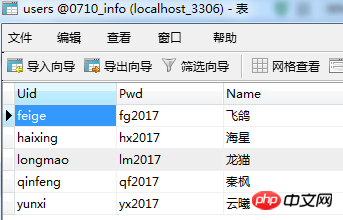
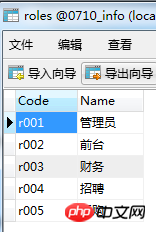
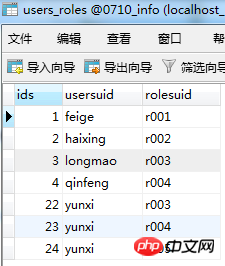
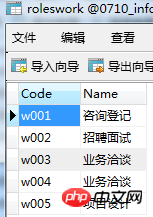
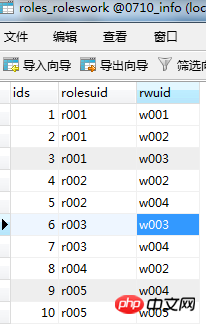
<!DOCTYPE html>
<html>
<head>
<meta charset="UTF-8">
<title>权限管理</title>
<script src="bootstrap/js/jquery-1.11.2.min.js"></script>
</head>
<body>
<h2>用户与角色管理</h2>
<p><select id="user">
<? "./DBDA.class.php" = = "select * from users" = ->query(,0( "<option value='{[0]}'>{[2]}</option>"?>
</select>
</p>
<br />
<p><? = "select * from roles" = ->query(,0( "<input type='checkbox' class='ck' value='{[0]}'>{[1]}"?>
</p>
<br />
<input type="button" value="确认" id="btn"/>
</body>
<script>"#user").change("#btn").click( uid = $("#user"). ck = $(".ck" role = "";
(i=0;i<ck.length;i++ v = ck.eq(i).(ck.eq(i).prop("checked"+= ck.eq(i).val()+"|".:"POST",:"RBbtnchuli.php",:{uid:uid,role:role},:"TEXT",:"修改成功!" uid = $("#user")..:"RBchuli.php",:{uid:uid},:"POST",:"TEXT",: role = data.("|" ck = $(".ck".prop("checked",(i=0;i<ck.length;i++ v = ck.eq(i).(role.indexOf(v)>=0.eq(i).prop("checked",</script>
</html><?php
$uid = $_POST["uid"];
require_once "./DBDA.class.php";
$db = new DBDA();
$sql = "select rolesuid from users_roles where usersuid=' {
$uid
}
'";
echo $db->StrQuery($sql,0);<?php
$uid = $_POST["uid"];
$role = $_POST["role"];//字符串
$role = substr($role,0,strlen($role)-1);
$arr = explode("|", $role);
require_once "./DBDA.class.php";
$db = new DBDA();
//删除
$sdel = "delete from users_roles where usersuid='{$uid}'";
$db->query($sdel);
//添加
foreach($arr as $v){
$sql = "insert into users_roles values(0,'{$uid}','{$v}')";
$db->query($sql);
}
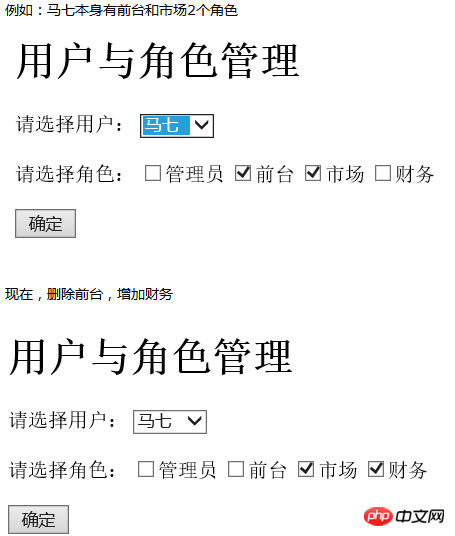
<!DOCTYPE html>
<html>
<head>
<meta charset="UTF-8">
<title></title>
<script src="bootstrap/js/jquery-1.11.2.min.js"></script>
<script src="bootstrap/js/bootstrap.min.js"></script>
<link href="bootstrap/css/bootstrap.min.css" rel="stylesheet" type="text/css"/>
</head>
<style>
.title{
margin-left: 600px;
margin-top: 150px;
} .quanju{
margin-left: 450px;
margin-top: -180px;
} .name,.pwd{
max-width: 120px;
} .yangshi1{
margin-top: 200px;
} </style>
<body>
<form class="form-horizontal" role="form" action="RBloginchuli.php" method="post">
<h3 class="title">用户登录</h3>
<p class="quanju">
<p class="form-group yangshi1">
<label for="firstname" class="col-sm-2 control-label">用户名:</label>
<p class="col-sm-10">
<input type="text" class="form-control name" name="uid" placeholder="请输入用户名">
</p>
</p>
<p class="form-group yangshi2">
<label for="lastname" class="col-sm-2 control-label">密码:</label>
<p class="col-sm-10">
<input type="text" class="form-control pwd" name="pwd" placeholder="请输入密码">
</p>
</p>
<p class="form-group">
<p class="col-sm-offset-2 col-sm-10">
<p class="checkbox">
<label>
<input type="checkbox">
保存密码 </label>
<label>
<input type="checkbox">
下次自动登录 </label>
</p>
</p>
</p>
<p class="form-group">
<p class="col-sm-offset-2 col-sm-10">
<button type="submit" class="btn btn-warning" value="登录" onclick="return login()" >
登录
</button>
</p>
</p>
</p>
</form>
</body>
</html><?phpsession_start();
$uid = $_POST["uid"];
$pwd = $_POST["pwd"];
require_once "./DBDA.class.php";
$db = new DBDA();
$sql = "select pwd from users where uid=' {
$uid
}
'";
$mm = $db->StrQuery($sql,0);
if(!empty($pwd) && $pwd==$mm) {
$_SESSION["uid"] = $uid;
header("location:RBmain.php");
}
else {
echo "<script>alert('用户名或密码有误!')</script>";
}<html>
<head>
<meta charset="UTF-8">
<title>权限主页面</title>
</head>
<body>
<?php
session_start();
if(empty($_SESSION["uid"])) {
header("location:RBlogin.php");
exit;
}
$uid = $_SESSION["uid"];
require_once "./DBDA.class.php";
$db = new DBDA();
//子查询 $sql = "select * from roleswork where code in (select * from roles_roleswork where rolesuid in (select * from users_roles where usersuid=' {
$uid
}
'))";
$arr = $db->query($sql,0);
foreach($arr as $v) {
echo "<p class='menu'> {
$v[1]
}
</p>";
}
?> </body>
</html>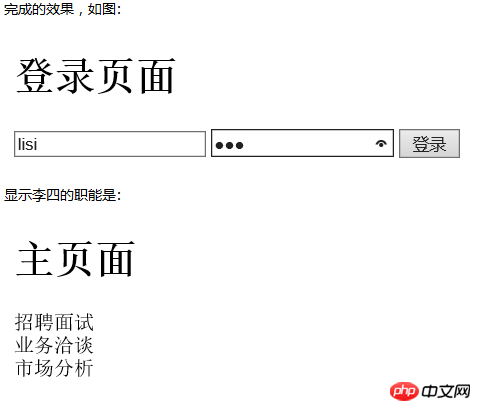
The above is the detailed content of How to implement rights management function in PHP. For more information, please follow other related articles on the PHP Chinese website!




